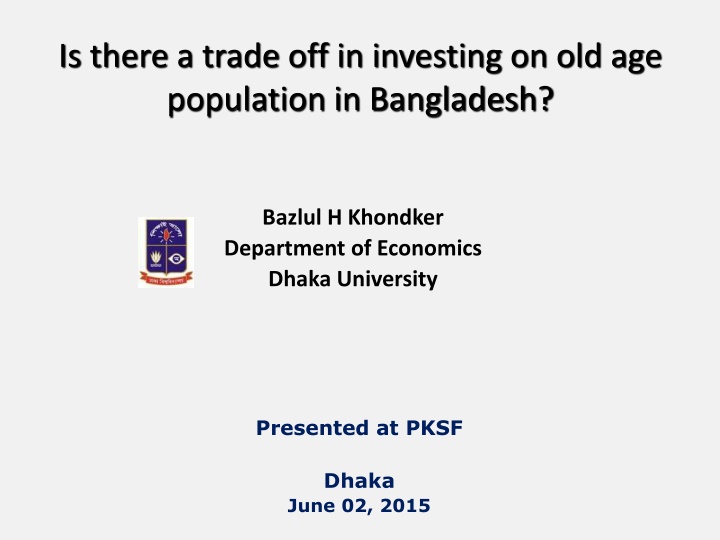
Investing in Old Age Population in Bangladesh: Assessing the Trade-offs
Explore the implications of investing in the elderly population in Bangladesh through a detailed analysis of poverty reduction, disability incidence, earning capacity, and gender disparities. Understand the challenges and potential strategies for enhancing the well-being of the aging demographic.
Download Presentation

Please find below an Image/Link to download the presentation.
The content on the website is provided AS IS for your information and personal use only. It may not be sold, licensed, or shared on other websites without obtaining consent from the author. If you encounter any issues during the download, it is possible that the publisher has removed the file from their server.
You are allowed to download the files provided on this website for personal or commercial use, subject to the condition that they are used lawfully. All files are the property of their respective owners.
The content on the website is provided AS IS for your information and personal use only. It may not be sold, licensed, or shared on other websites without obtaining consent from the author.
E N D
Presentation Transcript
Is there a trade off in investing on old age population in Bangladesh? Bazlul H Khondker Department of Economics Dhaka University Presented at PKSF Dhaka June 02, 2015
Introduction and Background Population ageing is one of the most significant trends of the 21th century. It is happening in all over the globe. Bangladesh-no exception. In 2010, around 7% of the population was aged over 60 years. Bangladesh will reach the 10% threshold when countries are considered as ageing in around 2026. By 2050, 60s + age group will comprise a massive 23% of the population. While comparing poverty rates across various age groups between 2005 and 2010, it appears that older people may have benefitted less from development gains in recent years. Against this background, here we assess current situation of old age population and also discusses a range of options for their well-being.
Longitudinal Analysis Reduction in poverty headcount rates between 2005-2010 by age of household head 12 10.8 10.5 10.3 10.3 % point reduction in poverty 10 9.3 8.7 8.5 7.7 7.5 8 6 6 5 4 2.7 2 0 All age <=29 30-39 40-49 50-59 60+ Lower poverty line Upper poverty line
Incidence of Higher Disability 35 30 Proportion of population (%) 25 20 15 10 5 0 5 - 9 10-14 15-24 25-34 35-44 45-54 55-64 65+ Eye sight Hearing Walking Mental Self-care Speaking Any disability Growing old is strongly associated with greater incidence of disability. Rates of disability are relatively consistent between the sexes, difficulties with walking and self-care are more common amongst older women. The greatest gender difference is reported for self-care, where older women are more than four times as likely as men to experience difficulty.
Lower Earning Capacity 100 Labour force participation 80 60 rate (%) 40 20 0 15-24 15-64 25-34 25-54 35-54 55-64 65+ Age group Men Women Incidence of disability in old age correlates strongly with lower labour force participation at older ages. Discrimination against older workers is another driver of lower labour force participation. Older people can face discrimination in the labour market, such as being denied access to micro-credit. A 2008 survey by HelpAge International found that only 19 % of older people in Bangladesh were able to access credit, compared to 45 % of poor adults.
Old Age and Gender Women Men 8.0% 31.3% Currently Married Widowed 67.1% 91.3% Gender has an important influence on the sources of support in old age. Older women are much more likely to be widowed than older men. This gap, is remarkably wide in Bangladesh, with over 90 % of older men still married but nearly two thirds of older women widowed. Many factors influenced this: men marrying women younger than themselves and having a higher likelihood of remarrying at older ages. The difference in marital status in old age suggests radically different experiences of old age according to gender. While the majority of older men will be able to look to their spouse for support in the case of illness or frailty, most older women will need to look to extended family members or the wider community.
Old Age Allowance in Bangladesh An overview Value of the OAA: monetary vs. estimated real prices Evolution of OAA Programme 350 300 Value of benefit (BDT) 250 200 150 100 50 0 2008 1998 1999 2000 2001 2002 2003 2004 2005 2006 2007 2009 2010 2011 2012 Current prices Real value (constant, 1998 prices) Source: Authors calculations based on Ministry of Social Welfare, Department of Social Services and International Monetary Fund, World Economic Outlook Database, April 2013 (for inflation figures, average consumer prices Source: Department of Social Services, website
Targeting performance How well does the OAA target the poorest? Distribution of OAA recipients by expenditure decile (2010) Male age <65 14% 20 Proportion of OAA recipient >50% inclusion error Above eligibili ty age 67% 15 households (%) 1516 15 Female age <62 19% 10 1211 9 5 7 7 5 3 0 1 2 3 4 Expenditure deciles 5 6 7 8 9 10 Households receiving OAA according to presence of age-eligible member (2010) Key issues: Lack of accountability, monitoring system, selection processes are not yet clear, open to political manipulation (Barkat et al, 2013). Beneficiaries and non-beneficiaries report selection processes to have been unfair, significant inclusion of underage, understaffing and not yet in urban areas (Begum & Wesumperuma in ADB 2012).
OAA Reform Proposal: Universal Citizen Pension Age eligibility: 60; Transfer: BDT 600/month; Universal BDT 68 billion or 0.65% of GDP FY2013. Poverty rate fell by 1.62 percentage-points for all HHs; and 5.76 percentage-points for HHs with 60+ population. Poverty impacts of universal pension scenarios all households 4.5 Percentage point reduction in headcountr 3.96 4 3.5 3 poverty rate (UPL) 2.57 2.5 1.77 2 1.62 1.5 1.14 1.11 0.86 0.78 1 0.71 0.63 0.33 0.5 0 65 (m) 62 (w) 60 65 70 60 65 70 60 65 70 60 300 600 1000 1600
OAA Reform Proposal: Universal Citizen Pension Poverty impacts of universal pension scenarios households with an older person 60+ 16 14.08 Percentage point reduction in headcountr poverty rate (UPL) 14 12 9.12 10 8 6.28 5.76 6 4.04 3.94 3.05 4 2.78 2.51 2.22 1.16 2 0 65 (m) 62 (w) 60 65 70 60 65 70 60 65 70 60 300 600 1000 1600 A consequent question of the above micro-simulation is their possible effect on key macro-variables (i.e. GDP). Or is there a trade off between investment in pension vs an infrastructure?
Simulation Set Up A SAM multiplier model is used to assess the macro- economic impacts of Universal Pension scheme and/or Investment project . Two simulations are carried out: Simulation 1: in the first simulation labelled OAA , 68 billion BDT has been transferred to all six representative household groups on basis of their observed share in old age population (i.e. those aged 60 and over). Simulation 2: instead of transferring 68 billion BDT to the six household groups, in the second simulation, labelled INV , the funds are allocated in equal proportion to two investment sectors namely (i) construction and (ii) machineries.
A Typical SAM Structure Y =f (X) Capital Accounts Current Accounts of Institutions Production Factor Household Government Enterprise RoW Total Total Domestic Demand Production (PA) Private Consumption Public Consumption Investment Input-output Exports Distribution of value added Factor (FP) Total Factor Income Exogenous (X) Endogenous (Y) Redistribution of value added (labour, capital and land) Inter- Household Transfers Total Household Income Government Transfers Household (HH) Enterprise Transfers Remittances Indirect Tax (Production and Import) Redistribution of capital value added Government (GoV) Corporation Tax Income Tax Redistribution of capital value added Total Enterprise Income Enterprise (ENT) Imports of Consumption Goods Household Savings Imports of Capital Goods Rest of the World (RoW) Intermediate Imports Unrelated Leakage Government Savings Enterprise Savings Foreign Savings Total Savings Capital (CAP) Sectoral Supply / Output Payments of Factors of Production Total Supply (TSS) Outlays by Household Outlays by Government Outlays by Enterprises Investment
Macro Impact simulations; SAM model Measuring change in: Investment in construction machinery (50:50) (68 billion BDT) Domestic output by major activities Agriculture Manufacturing Construction Transport Services Value added by factors Labour Capital Land Consumption by Household type Rural land based Rural non-farm urban Y3= Y1=Output of Domestic Activity Commodity Y2 = GDP (Factor Income) Y4 = Household Income OAA transfer to households (68 billion BDT) Transmission Mechanisms and Impact Paths of Intervention into Activities and Households
Impacts on major activities Per cent Change in Domestic Output OAA_Agriculture INV_Agriculture OAA_Manufacturing INV_Manufacturing OAA_Construction INV_Construction OAA_Transport INV_Transport OAA_Services INV_Services OAA_Output INV_Output 0.00 0.20 0.40 0.60 0.80 1.00 1.20 1.40 1.60 1.80 OAA_Agriculture refers to impact on agricultural output due to old age allowance; INV_Agriculture stands for impact on agricultural output due to investment project. Agriculture is the largest beneficiary activity OAA while construction is the largest beneficiary activity Investment project. Impacts of OAA and Investment project on output is more or less similar.
Impact on factor income Per cent Change in Value Added OAA_Labour INV_Labour OAA_Capital INV_Capital OAA_Land INV_Land OAA_Value Added INV_Value Added 0.00 0.20 0.40 0.60 0.80 1.00 1.20 As Agriculture is the largest beneficiary activity land factor income is highest under OAA. While under INV capital factor is the highest gainer. Impacts of OAA and Investment project on Value added is more or less similar.
Impact on household consumption Percent Change in Household Consumption OAA_"Rural Land Based" INV_"Rural Land Based" OAA_"Rural Non-Farm" INV_"Rural Non-Farm" OAA_"Urban" INV_"Urban" OAA_"Consumption" INV_"Consumption" 0.00 0.50 1.00 1.50 2.00 2.50 3.00 Impacts of OAA on consumption is significantly higher the impact of equivalent Investment project. Land factor income growth led to the largest consumption gain for the rural land based household.
Conclusion A pension and infrastructure investments would have comparable impact on economic growth. A benefit level of Taka 600 to people aged 60 and over would cost 68 billion BDT, additional 0.5% of GDP. Would lift 2.5 million people out of poverty and reduce the poverty rate of the population living with older people (32% of the population) by 6 percentage points.
Recommendation 1. Recreational center for the Older people. 2. Introduce pension for PKSF beneficiaries aged 45. 3. Effective linkages between PKSF beneficiaries with local level health services at no or low cost. 4. Extending Career and Employment Services to Older people. 5. Extending the subsidized credit facilities for senior entrepreneurs. 6. Campaign to introduce subsidized transportation and entertainment facilities for the senior citizens. 7. Reform the OAA to improve targeting and enhance coverage and transfer amount of the OAA.

